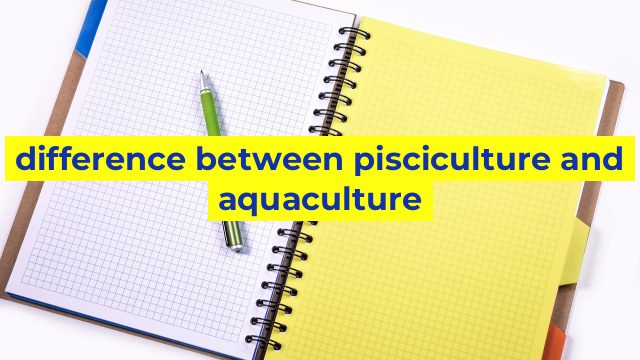The Difference Between Pisciculture and Aquaculture
If you’re anything like the average person, you might use the terms “pisciculture” and “aquaculture” interchangeably. After all, both words refer to the farming of fish! But did you know that there are important distinctions between the two?
What is Aquaculture?
Aquaculture is the practice of growing aquatic plants and animals in controlled environments, such as ponds, tanks, or ocean cages. This can include fish, crustaceans, mollusks, and aquatic plants. Aquaculture is hugely important for the global food supply, with a reported 50% of the fish we consume worldwide coming from aquaculture.
One of the key benefits of aquaculture is that it can be sustainable and environmentally friendly. By cultivating fish and other aquatic life in controlled environments, we can help to reduce overfishing and restore depleted populations. Additionally, aquaculture can reduce the need for wild-caught fish, which can have harmful effects on the wider ecosystem.
What is Pisciculture?
Pisciculture, on the other hand, refers specifically to the farming of fish. While it encompasses many of the same practices as aquaculture, it narrows in on just one type of aquatic life.
Pisciculture can be conducted on small scales, such as in backyard fish ponds, or on large commercial farms, with systems ranging from closed tanks to open-water enclosures. It can also be used as a tool for conservation, with programs like hatcheries and fish stocking helping to rebuild populations of endangered fish species.
The key difference between pisciculture and aquaculture is that the former refers solely to fish farming, while the latter covers a broader range of aquatic life.
Conclusion
While the terms “pisciculture” and “aquaculture” may seem interchangeable, there are important distinctions between the two. While aquaculture encompasses many different types of aquatic life, pisciculture refers specifically to the farming of fish. Both practices are critical for feeding our growing population and promoting sustainability in our food systems.
Table difference between pisciculture and aquaculture
| Parameter | Pisciculture | Aquaculture |
|---|---|---|
| Definition | The cultivation of fish in artificial ponds or tanks. | The cultivation of aquatic organisms (including fish, crustaceans, mollusks, and plants) in regulated water environments. |
| Scope | Primarily refers to the farming of fish for food or recreation. | Can include the farming of various aquatic animals and plants for food, recreation, research, and conservation purposes. |
| Methods | Fish are reared in limited water bodies, usually in a confined space, and fed with artificial feeds. | Aquatic organisms are reared in regulated water environments, such as ponds, tanks, cages, or open waters, using a variety of methods such as feeding, control of water quality, and disease prevention. |
| Target species | Primarily focuses on the farming of freshwater fish species such as Catla, Rohu, and Tilapia. | Includes a variety of aquatic species such as fish, shrimp, oysters, mussels, algae, and seaweed. |
| Environmental impact | Can cause negative environmental impacts such as water pollution, habitat destruction, and the spread of diseases and parasites. | Can also have environmental impacts but is often seen as a sustainable method of food production that can reduce pressure on wild fish stocks. |
| Economic significance | Most commonly practiced in developing countries as a means of food security and income generation. | Is a rapidly growing industry worldwide and contributes to global food security and economic growth. |
